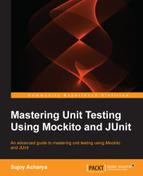Look at the
PhoneBookDerbyDao class. It has 398 lines to support create, read, update, and delete (CRUD) operations. Every method performs almost similar tasks. The following tasks are invoked from the CRUD methods:
- Passing connection parameters
- Opening a connection
- Creating a statement
- Preparing the statement
- Executing the statement
- Iterating through the results (only in the read method)
- Populating the model objects (only in the read method)
- Processing any exception
- Handling transactions
- Closing the ResultSet (only in the read method)
- Closing the statement
- Closing the connection
The Spring framework provides APIs to reduce JDBC code duplication. Spring JDBC hides the low-level details and allows us to concentrate on business logic. We'll implement PhoneBookDao using Spring JDBC.
Download the latest version of JDBC JAR and its dependencies from http://maven.springframework.org/release/org/springframework/spring/.
Follow the ensuing steps to implement Spring JDBC and simplify the code:
- Launch Eclipse, open the
DatabaseAccessproject, and edit.classpathto add the following Spring dependencies shown in the screenshot:
- Create a
PhoneBookDerbySpringDaoclass that implements thePhoneBookDaointerface. The following is the Spring implementation of thecreatemethod:public class PhoneBookDerbySpringDao implements PhoneBookDao { private final JdbcTemplate jdbcTemplate; public PhoneBookDerbySpringDao(JdbcTemplate jdbcTemplate) { this.jdbcTemplate = jdbcTemplate; } @Override public boolean create(PhoneEntry entry) { int rowCount = jdbcTemplate.update("insert into PhoneBook values (?,?,?)", new Object[]{entry.getPhoneNumber(), entry.getFirstName(), entry.getLastName() }); return rowCount == 1; } }JdbcTemplatesimplifies the use of JDBC; it handles the resources and helps to avoid common errors such as not closing the connection. It creates and populates thestatementobject, iterates through theResultSetobject, which leaves the application code to provide SQL, and extracts results.PhoneBookDerbySpringDaocontains aJdbcTemplateinstance and delegates the database tasks to thejdbcTemplate.JdbcTemplatehas an update method for insert and update operations. It takes a SQL query and parameters. The new Spring version of thecreate()method invokes theupdate()method onjdbcTemplateand passesPhoneEntrydetails. Now thecreatemethod looks simple, just two lines of code. The Spring framework handles the resource life cycle. - Create a JUnit class named
PhoneBookDerbySpringDaoTestfor unit testing. We'll create ajdbcTemplatemock and pass it to dao. The following is the JUnit implementation:@RunWith(MockitoJUnitRunner.class) public class PhoneBookDerbySpringDaoTest { @Mock JdbcTemplate mockJdbcTemplate; PhoneBookDerbySpringDao springDao; @Before public void init() { springDao = new PhoneBookDerbySpringDao(mockJdbcTemplate); } @Test public void creates_PhoneEntry() throws Exception { //create PhoneEntry String charlsPhoneNumber = "1234567"; String charlsFirstName = "Charles"; String charlsLastName = "Doe"; PhoneEntry charles = new PhoneEntry(); charles.setFirstName(charlsFirstName); charles.setLastName(charlsLastName); charles.setPhoneNumber(charlsPhoneNumber); //Stub jdbcTemplate's update to return 1 when(mockJdbcTemplate.update(anyString(), anyObject(), anyObject(), anyObject())).thenReturn(1); //Execute assertTrue(springDao.create(charles)); //Create argument capture ArgumentCaptor<Object> varArgs = ArgumentCaptor.forClass(Object.class); ArgumentCaptor<String> strArg = ArgumentCaptor.forClass(String.class); //Verify update method was called and capture args verify(mockJdbcTemplate).update(strArg.capture(),varArgs.capture(),varArgs.capture(), varArgs.capture()); //Verify 1st dynamic argument was the phone number assertEquals(charlsPhoneNumber, varArgs.getAllValues().get(0)); //Verify the name arguments assertEquals(charlsFirstName, varArgs.getAllValues().get(1)); assertEquals(charlsLastName, varArgs.getAllValues().get(2)); } }Look at the new Spring dao; it is only 54 lines long. The class looks neat, simple, and readable. It doesn't handle resources, it rather concentrates on data access.
